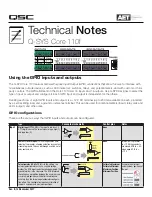
11-2
|
ni.com
Chapter 11
Triggering
Triggering with an Analog Source
Some M Series devices can generate a trigger on an analog signal. To find your device triggering
options, refer to the specifications document for your device.
Figure 11-2 shows the analog trigger circuit.
Figure 11-2.
Analog Trigger Circuit
You must specify a source and an analog trigger type. The source can be either an APFI <0,1>
terminal or an analog input channel.
APFI <0,1> Terminals
When you use either APFI <0,1> terminal as an analog trigger, you should drive the terminal
with a low impedance signal source (less than 1 k
Ω
source impedance). If APFI <0,1> are left
unconnected, they are susceptible to crosstalk from adjacent terminals, which can cause false
triggering. Note that the APFI <0,1> terminals also can be used for other functions such as the
AO External Reference input, as described in the
AO Offset and AO Reference Selection
of Chapter 5,
.
Analog Input Channels
Select any analog input channel to drive the NI-PGIA. The NI-PGIA amplifies the signal as
determined by the input ground-reference setting and the input range. The output of the NI-PGIA
then drives the analog trigger detection circuit. By using the NI-PGIA, you can trigger on very
small voltage changes in the input signal.
When the DAQ device is waiting for an analog trigger with a AI channel as the source, the AI
muxes should not route different AI channels to the NI-PGIA. If a different channel is routed to
the NI-PGIA, the trigger condition on the desired channel could be missed. The other channels
also could generate false triggers.
An
a
log
Inp
u
t
Ch
a
nnel
s
PGIA
–
+
ADC
M
u
x
An
a
log
Trigger
Detection
An
a
log Comp
a
ri
s
on
Event
(An
a
log Trigger
Circ
u
itry O
u
tp
u
t)
APFI <0,1>
AI Circ
u
itry
AO Circ
u
itry
Co
u
nter Circ
u
itry
















































